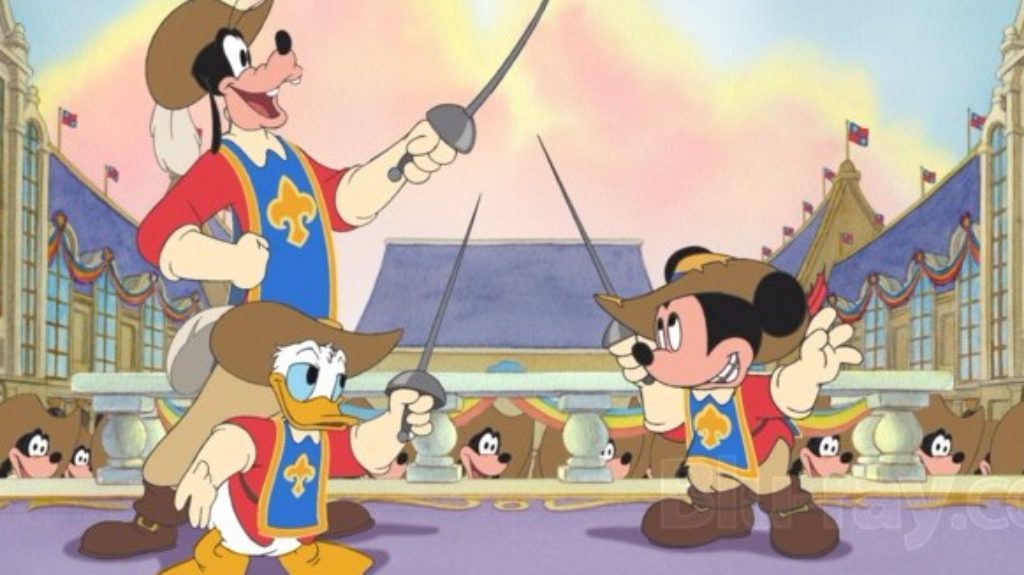
Alexandre Dumas first wrote The Three Musketeers as a serial for a French magazine in 1844. It later became a novel and has inspired countless movies. But even if Dumas had been able to predict the advent of film, he never could’ve foreseen that, 160 years after its introduction, The Three Musketeers would be adapted into an animated musical starring a mouse, a duck and a lop-eared, buck-toothed canine.
This hour-long, straight-to-video adventure finds a trio of Musketeer hopefuls bumbling through life as 17th century janitors. Alas, the royal guard is beyond their reach. Mickey is too small. Donald is scared of his own shadow. And Goofy isn’t nearly bright enough. The boorish Captain Pete mocks them, then decides that assigning them to guard Princess Minnie might work to his advantage as he and his henchmen try to wrangle the throne away from her. Pete plans to kidnap the princess and set himself up as king. Stopping him will require more of Mickey, Donald and Goofy than simply donning uniforms, sprucing their plumes and shouting “All for one and one for all!” While teamwork is critical, each of the newly appointed Musketeers must dig deep inside to overcome his greatest weakness. There’s also plenty of singing to revered arrangements by Offenbach, Tchaikovsky, Strauss, Grieg, Bizet and Beethoven. Yes, singing. The folks at Disney have taken the liberty of penning lyrics to classical masterpieces ranging from “The Blue Danube” to “The Nutcracker.”
Mickey, Donald and Goofy want to be Musketeers because, as kids, royal Musketeers rescued them from young bullies. Dreams are never too big for friends who “work hard and stick together.” Captain Pete sees struggling janitors, but Mickey sees a crisis as an opportunity (“We’re practicing our teamwork so we can be good Musketeers”). The mouse also believes in bravery and duty to the uniform—loyally serving something greater than himself. Acknowledging his personal limitations, Mickey finds strength in his like-minded comrades (“I may be small, but I have friends that make me 10 feet tall”). A painful experience isn’t for naught when Goofy intentionally repeats it so as to rescue his buddy. It suggests that people can actually benefit from their hardships. Cheating and lying are condemned because these traits are attractive to the villainous Pete. Goofy proves that a soft answer can win over hostile people (Proverbs 15:1).
While not exactly “sexual,” each of our three heroes lands a lady friend by the end, which involves kissing and hugging.
There are many wild mishaps and pratfalls (characters get whacked by a door, smacked with a lute, kicked by a cow, etc.). Intentional hostility ranges from nonfatal swordplay and fisticuffs to the Beagle Boys trying to drop a safe on Princess Minnie. Weapons are usually used simply to threaten and intimidate. As Clarabelle prepares to send Goofy to a watery grave, we see skeletons at the bottom of the river. Chained in a cell, Mickey nearly drowns from the rising tide. Donald narrowly escapes a guillotine, which chops off the end of Pete’s peg leg instead. Pete punches Mickey before Donald and Goofy swoop in and help the mouse beat up the bully.
Mickey, Donald and Goofy are referred to as “screw-ups.” Pete calls Goofy a “doofus.”
None.
Pete rudely sticks his tongue out and gives the good guys the raspberries. Although Minnie dreams of finding true love, she embraces an overly romantic notion that includes “love at first sight” and the idea that love is even better when it is forbidden. As is the case with most secular kid flicks, the source of strength comes entirely from within rather than from above.
Clocking in at a mere 68 minutes, Disney’s latest adaptation of The Three Musketeers (the studio’s 1993 live-action version starred Charlie Sheen and Kiefer Sutherland) is an entertaining enough trifle that could introduce children to classic literature. Of course, purists may bristle at how the Mouse House has rewritten the story. Let’s face it, though, what Disney cartoon—from Pinocchio to The Little Mermaid—hasn’t put its own spin on someone else’s tale? We’ve come to expect that.
What’s considerably more jarring is what this creative team has done to some of classical music’s most elegant and cherished works. I’m no snob. I have no problem merging madcap animation with Tchaikovsky and Beethoven. In fact, my earliest introduction to the masters was probably through Bugs Bunny cartoons. Disney’s Fantasia films are a thing of beauty. But the decision to saddle “Orpheus in the Underworld,” “Peer Gynt Suite” and other classics with limp lyrics is nothing short of audacious—like painting roller skates on Whistler’s Mother. It just feels wrong.
That’s probably not enough to put most families off this otherwise enjoyable caper, though, where good conquers evil and there’s lots of colorful fun and boisterous spills along the way. (Mickey, Donald and Goofy always seem to possess a Three Stooges clumsiness, but with a much greater affection for one another.) Mickey, Donald, Goofy: The Three Musketeers ultimately reinforces virtues including unity, friendship, bravery, ingenuity and perseverance.
